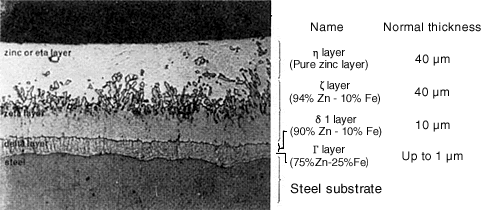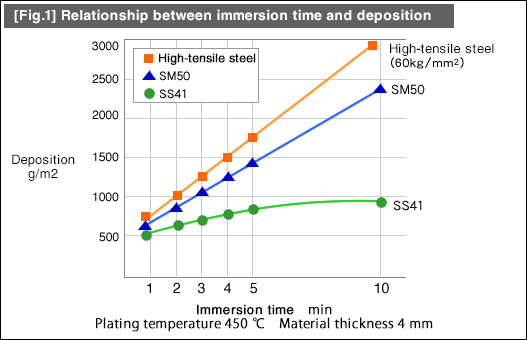#209 Hot Dip Galvanizing -2
(2) Hot dipping process
After the pretreatment process, dip the product into a bath of molten zinc around 460°C. Wait for an appropriate length of time, and then lift the product up from the molten zinc bath after removing zinc oxide particles floating on the surface.After allowing excess molten zinc to drip off by applying light impact, cool the product.

As shown in the cross-section image above, the plating film consists of a zinc layer on the top and an alloy layer formed by the reaction of molten zinc with steel.The thickness and composition of an alloy layer are determined by the chemical composition of steel and operating conditions. The thickness of the topmost zinc layer is determined by factors such as the bath temperature and speed of withdrawing the product from the plating bath.
(1) Plating temperature
In most cases, the temperature is set between 440 and 470°C. Special items such as bolts may be plated at a higher temperature.The plating temperature should be kept as low as possible so that it will not compromise the drip-off performance when withdrawing the product from the zinc-plating bath.
If the bath temperature is too high, it increases the zinc reactivity. As a result, it generates more zinc oxide and shortens the life of the plating bath.Although a higher temperature improves the fluidity of zinc, it roughens the alloy layer structure and its surface. On the other hand, if the bath temperature is too low, the plating film tends to be extremely think and uneven.
(2) Immersion time
In general, the longer the immersion time, the greater the amount of zinc deposition is.[Fig.1] shows the deposition conditions for general steel and high-tensile steel materials.

- Environmental conservation
- Hot Dipping
- Anodic Oxidation Process
- Anodic oxidation treatment
- Anodizing
- Corrosion - Corrosion Protection
- Electroless Plating
- Electroplating
- Heat treating
- Hydrogen embrittlement
- Metal cleaning
- Metal etching
- Painting
- Special paints
- Surface Treatment
- Surface-treated steel sheets
- Thermal Spraying



